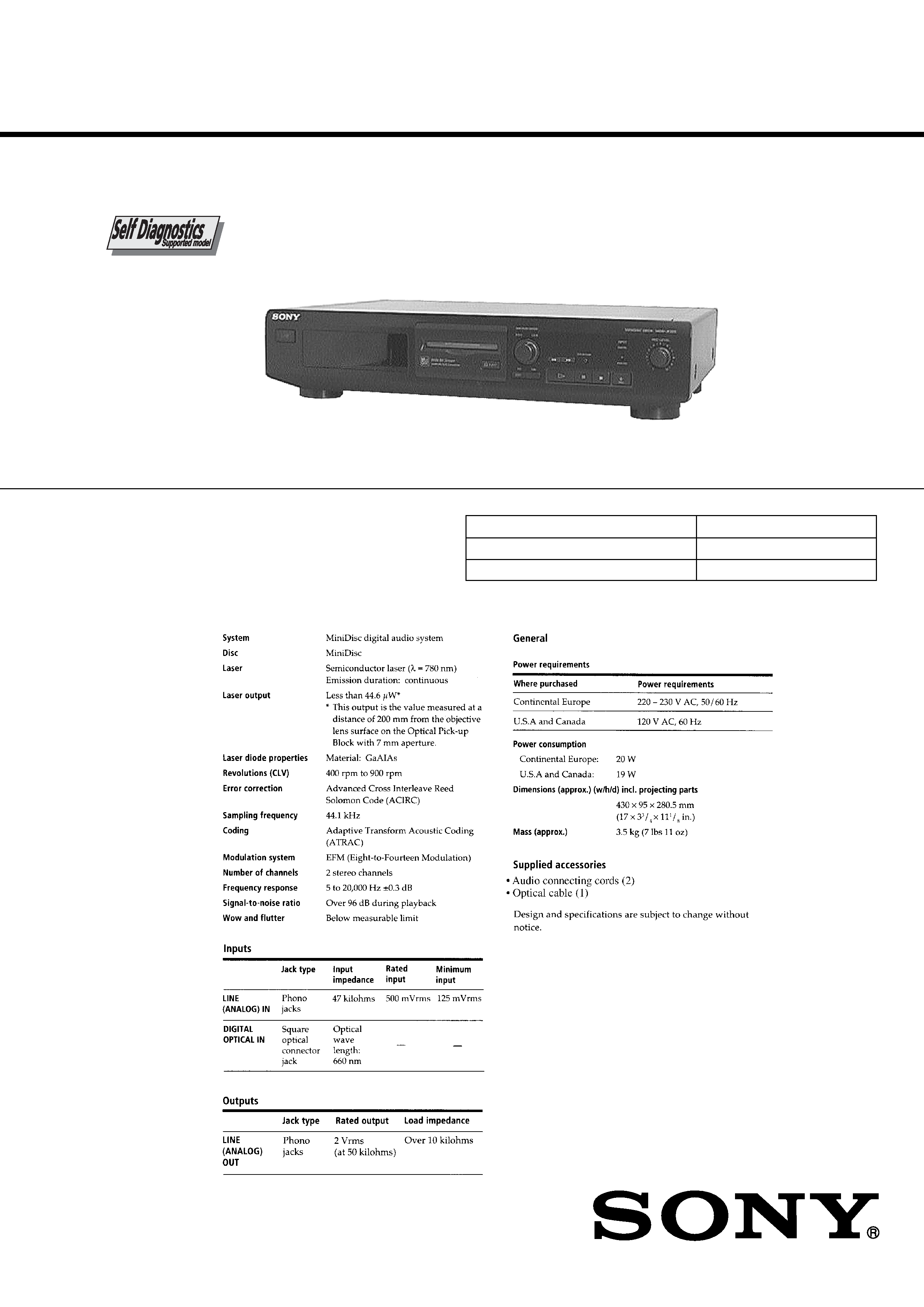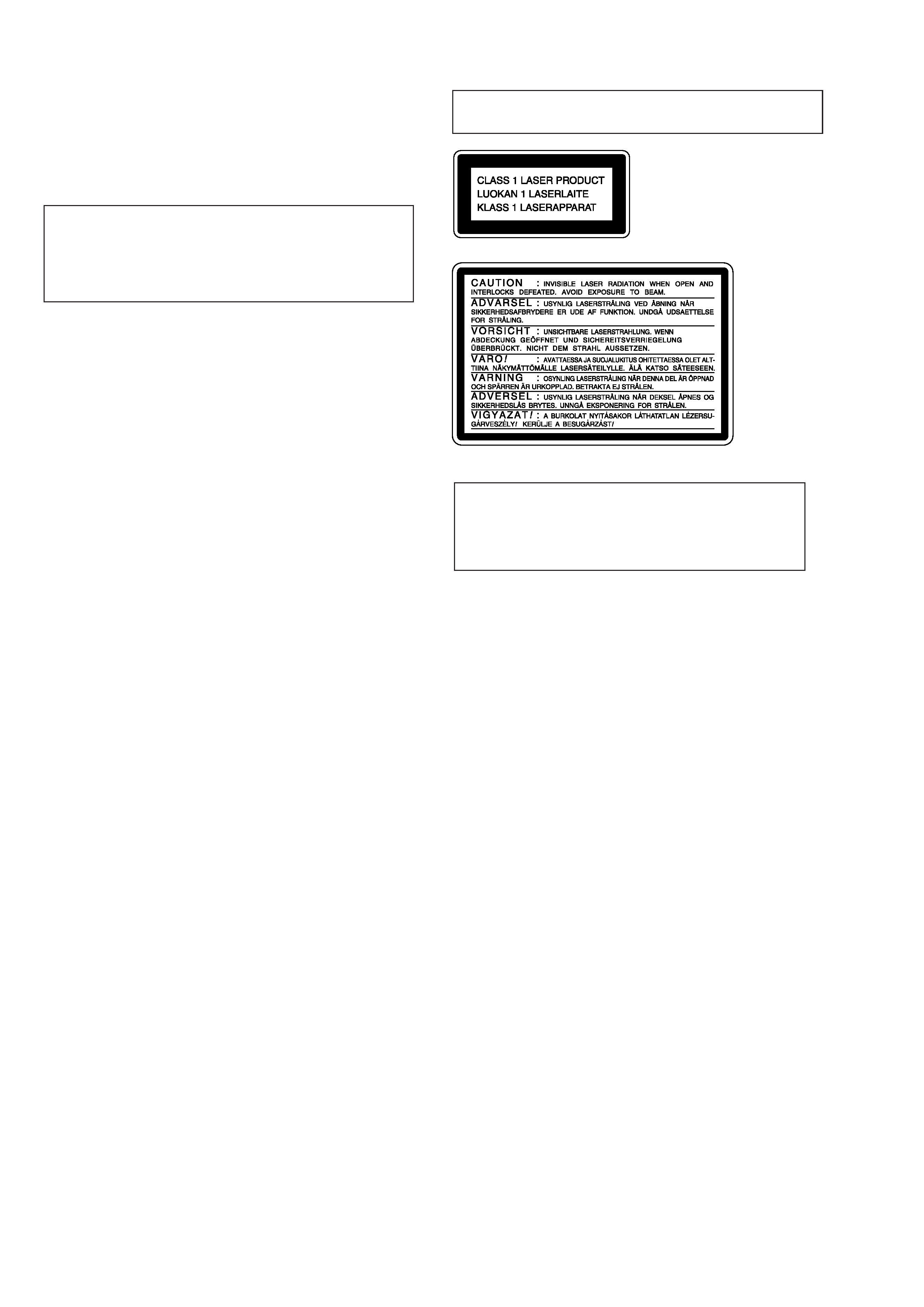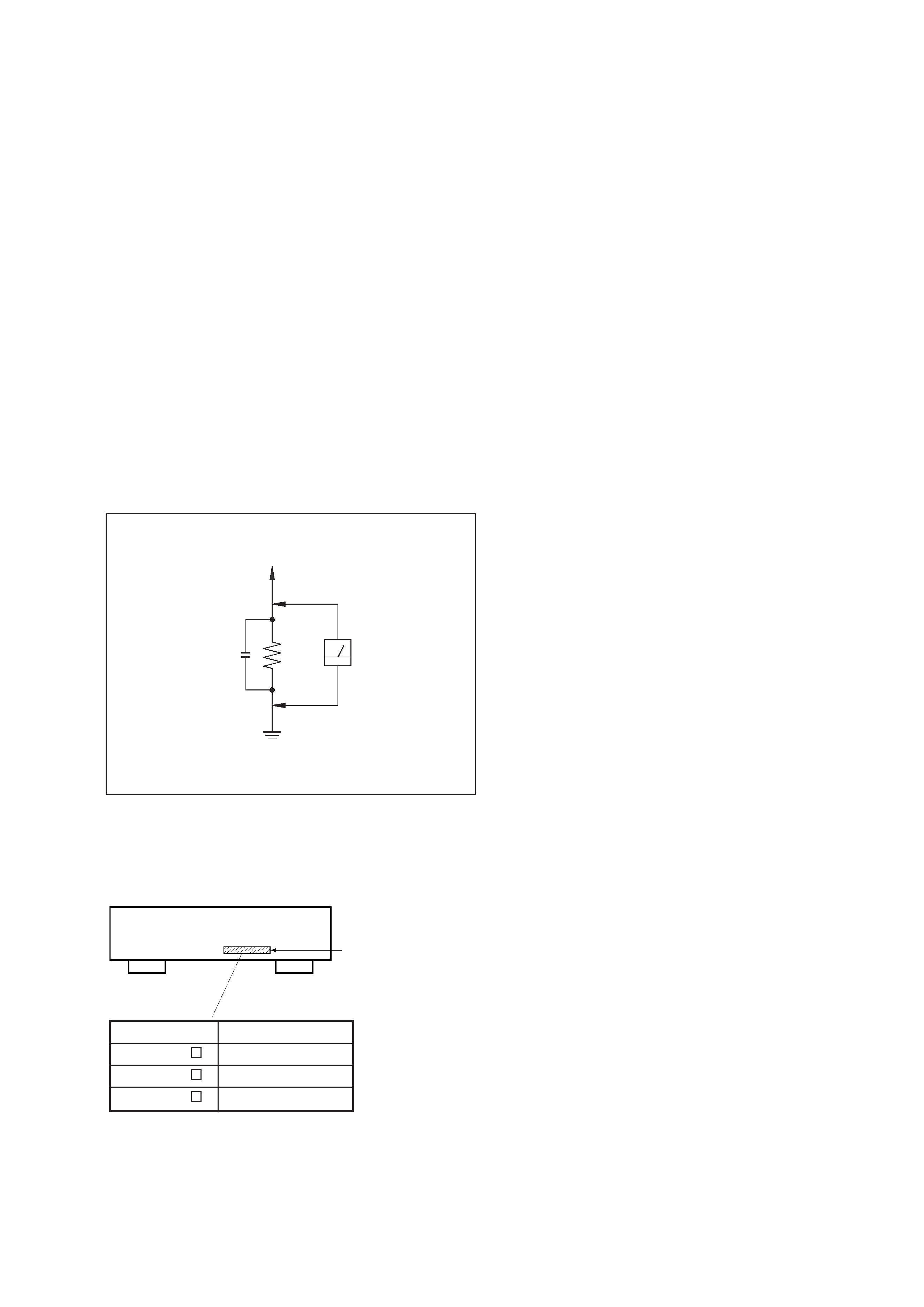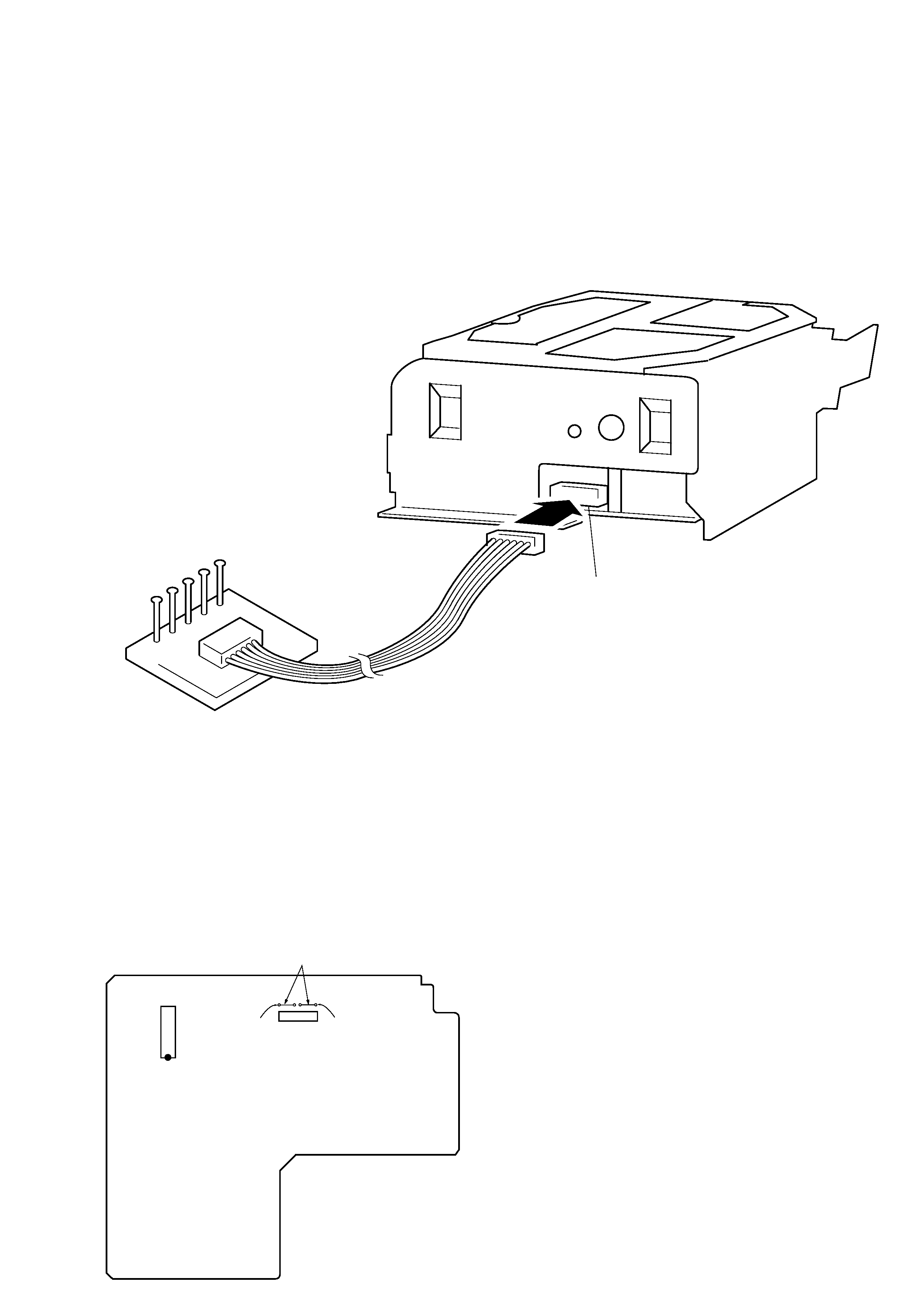
MDS-JE320
US Model
Canadian Model
AEP Model
SERVICE MANUAL
Model Name Using Similar Mechanism
MDS-JE510
MD Mechanism Type
MDM-3GC
Optical Pick-up Type
KMS-260A/J1NP
MINIDISC DECK
SPECIFICATIONS
Ver. 1.1 2004. 12
Sony Corporation
Audio Group
Published by Sony Engineering Corporation
9-922-894-12
2004L16-1
© 2004.12

-- 2 --
CAUTION
Danger of explosion if battery is incorrectly replaced.
Replace only with the same or equivalent type recommended by
the equipment manufacturer.
Discard used batteries according to manufacture's instructions.
ADVARSEL!
Lithiumbatteri - Eksplosionsfare ved fejlagtig håndtering.
Udskiftning må kun ske med batteri af samme fabrikat og type.
Levér det brugte batteri tilbage til leverandøren.
ADVARSEL
Eksplosjonsfare ved feilakting skifte av batteri.
Benytt samme batteritype eller en tilsvarende type anbefalt av
apparatfabrikanten.
Brukte batterier katterier kasseres i henhold til fabrikantens
VARNIG
Explosionsfara vid felaktigt batteribyte.
Använd samma batterityp eller en likvärdig typ som rekommenderas
av apparattillverkaren.
Kassera använt batteri enligt gällande föreakrifter.
VAROITUS
Parist voi räjähtää, jos se on virheellisesti asennettu.
Vaihda paristo ainoastaan laitevalmistajan suosittelemaan tyyppiin.
Hävitä käytetty paristo valmistajan ohjeiden mukaisesti.
CAUTION
Use of controls or adjustments or performance of
procedures other than those specified herein may result in
hazardous radiation exposure.
Notes on chip component replacement
· Never reuse a disconnected chip component.
· Notice that the minus side of a tantalum capacitor may be
damaged by heat.
Flexible Circuit Board Repairing
· Keep the temperature of soldering iron around 270°C
during repairing.
· Do not touch the soldering iron on the same conductor of the
circuit board (within 3 times).
· Be careful not to apply force on the conductor when soldering
or unsoldering.
Laser component in this product is capable of emitting radiation
exceeding the limit for Class 1.
This appliance is classified as a
CLASS 1 LASER product.
The CLASS 1 LASER
PRODUCT MARKING is
located on the rear exterior.
This caution label is located inside the unit.
ATTENTION AU COMPOSANT AYANT RAPPORT
À LA SÉCURITÉ!!
LES COMPOSANTS IDENTIFIÉS PAR UNE MARQUE
!SUR
LES DIAGRAMMES SCHÉMATIQUES ET LA LISTE DES
PIÈCES SONT CRITIQUES POUR LA SÉCURITÉ DE
FONCTIONNEMENT. NE REMPLACER CES COMPOSANTS
QUE PAR DES PIÈCES SONY DONT LES NUMÉROS
SONT DONNÉS DANS CE MANUEL OU DANS LES
SUPPLÉMENTS PUBLIÉS PAR SONY.
SAFETY-RELATED COMPONENT WARNING !!
COMPONENTS IDENTIFIED BY MARK
! OR DOTTED LINE WITH
MARK
! ON THE SCHEMATIC DIAGRAMS AND IN THE PARTS
LIST ARE CRITICAL TO SAFE OPERATION. REPLACE THESE
COMPONENTS WITH SONY PARTS WHOSE PART NUMBERS
APPEAR AS SHOWN IN THIS MANUAL OR IN SUPPLEMENTS
PUBLISHED BY SONY.

-- 3 --
SAFETY CHECK-OUT
After correcting the original service problem, perform the following
safety checks before releasing the set to the customer:
Check the antenna terminals, metal trim, "metallized" knobs, screws,
and all other exposed metal parts for AC leakage. Check leakage as
described below.
LEAKAGE
The AC leakage from any exposed metal part to earth Ground and
from all exposed metal parts to any exposed metal part having a
return to chassis, must not exceed 0.5 mA (500 microampers).
Leakage current can be measured by any one of three methods.
1.
A commercial leakage tester, such as the Simpson 229 or RCA
WT-540A. Follow the manufacturers' instructions to use these
instruments.
2.
A battery-operated AC milliammeter. The Data Precision 245
digital multimeter is suitable for this job.
3.
Measuring the voltage drop across a resistor by means of a
VOM or battery-operated AC voltmeter. The "limit" indication
is 0.75 V, so analog meters must have an accurate low-voltage
scale. The Simpson 250 and Sanwa SH-63Trd are examples of
a passive VOM that is suitable. Nearly all battery operated
digital multimeters that have a 2V AC range are suitable. (See
Fig. A)
Parts No.
4-990-651-1
4-990-651-4
4-990-651-5
Model
US model
Canadian model
AEP model
TABLE OF CONTENTS
1. SERVICING NOTE .......................................................... 5
2. GENERAL .......................................................................... 8
3. DISASSEMBLY
3-1. Case and Front Panel Assembly ...................................... 9
3-2. Bracket (T), (L) and (R) .................................................. 9
3-3. BD Board ...................................................................... 10
3-4. SUB Chassis ................................................................. 10
3-5. Shutter Assembly .......................................................... 11
3-6. Over Write Head ........................................................... 11
3-7. Slider Complete Assembly ............................................ 12
4. TEST MODE ..................................................................... 13
5. ELECTRICAL ADJUSTMENTS ............................... 16
6. DIAGRAMS
6-1. Brock Diagrams
· BD Section ....................................................................... 21
· Main Section .................................................................... 23
6-2. Circuit Boards Location ................................................ 25
6-3. Printed Wiring Board -- BD Section -- ...................... 27
6-4. Schematic Diagram -- BD Section (1/2) -- ................ 29
6-5. Schematic Diagram -- BD Section (2/2) -- ................ 31
6-6. Printed Wiring Board -- Main Section -- .................... 33
6-7. Schematic Diagram -- Main Section (1/3) -- .............. 35
6-8. Schematic Diagram -- Main Section (2/3) -- .............. 37
6-9. Schematic Diagram -- Main Section (3/3) -- .............. 39
6-10. Printed Wiring Board -- Display Section -- .............. 41
6-11. Schematic Diagram -- Display Section -- ................ 43
6-12. Printed Wiring Board -- Switch Section -- ............... 45
6-13. Schematic Diagram -- Switch Section -- .................. 47
6-14. IC Brock Diagrams -- BD Section-- ......................... 49
6-15. IC Pin Functions ......................................................... 54
7. EXPLODED VIEWS
7-1. Main Section ................................................................. 63
7-2. Front Panel Section ....................................................... 64
7-3. Mechanism Deck Section (1) (MDM-3GC) ................. 65
7-4. Mechanism Deck Section (2) (MDM-3GC) ................. 66
8. ELECTRICAL PARTS LIST ........................................ 67
MODEL IDENTIFICATION
-- BACK PANEL --
Parts No.
To Exposed Metal
Parts on Set
0.15
µF
1.5 k
AC
Voltmeter
(0.75 V)
Earth Ground
Fig. A. Using an AC voltmeter to check AC leakage.

-- 4 --
[SELF-DIAGNOSIS FUNCTION]
The self-diagnosis function consists of error codes for users which are displayed automatically when errors occur, and error codes which show the error
history in the test mode during servicing.For detail on how to view error codes for users, refer to the following box in the instruction manual.
Self-Diagnosis Function
The deck has a self-diagnosis display. This function shows a three-digit display (a combination of a letter and figures)
and the corresponding message alternately, so you can check the deck's condition. If such a display appears, check the
following table in order to resolve the problem. Should any problem persist, consult your nearest Sony dealer.
Three-digit display/Message
Cause/Remedy
C11/Protected
The inserted MD is record-protected.
/Take out the MD, and close the record-protect tab (page 9.)
C13/REC Error
The recording was not made properly.
/Set the deck in a stable place, and repeat the recording procedure.
The inserted MD is dirty (with smudges, fingerprints, etc.) scratched, or not up to standards.
/Replace the disc, and repeat the recording procedure.
C13/Disc Error
The deck could not read the TOC of the MD properly.
/Take out the MD, and insert it again.
C14/Disc Error
The deck could not read the TOC of the MD properly.
/Insert another disc.
/If possible, erase all tracks on the MD using the All Erase Function on page 28.
C71/Din Unlock
A moment's lighting is due to the signals of the digital program being recorded.
This does not affect the recorded material.
While recording from a digital component connected through the digital input connector,
the digital connecting cable was unplugged or the digital component turned off.
/Connect the cable or turn the digital component back on.
C11
Protected
Self-diagnosis display

-- 5 --
SECTION 1
SERVICING NOTE
JIG FOR CHECKING BD BOARD WAVEFORM
The special jig (J-2501-124-A) is useful for checking the waveform of the BD board. The names of terminals and the checking items to be
performed are shown as follows.
I+3V : For measuring IOP (Check the deterioration of the optical pick-up laser)
IOP
: For measuring IOP (Check the deterioration of the optical pick-up laser)
TEO : TRK error signal (Traverse adjustment)
VC
: Reference level for checking the signal
RF
: RF signal (Check jitter)
FORCED RESET
The system microprocessor can be reset in the following way.
Use these methods when the unit cannot be operated normally due to the overrunning of the microprocessor, etc.
Method :
Disconnect the power plug, short-circuit jumper wire of JW70 and JW181.
[MAIN BOARD] (Component Side)
Mechanism deck
CN110
RF
VC
TEO
IOP
I + 3V
Jig
(J-2501-124-A)
Jumper wire
JW181
JW70
BT301
IC301
